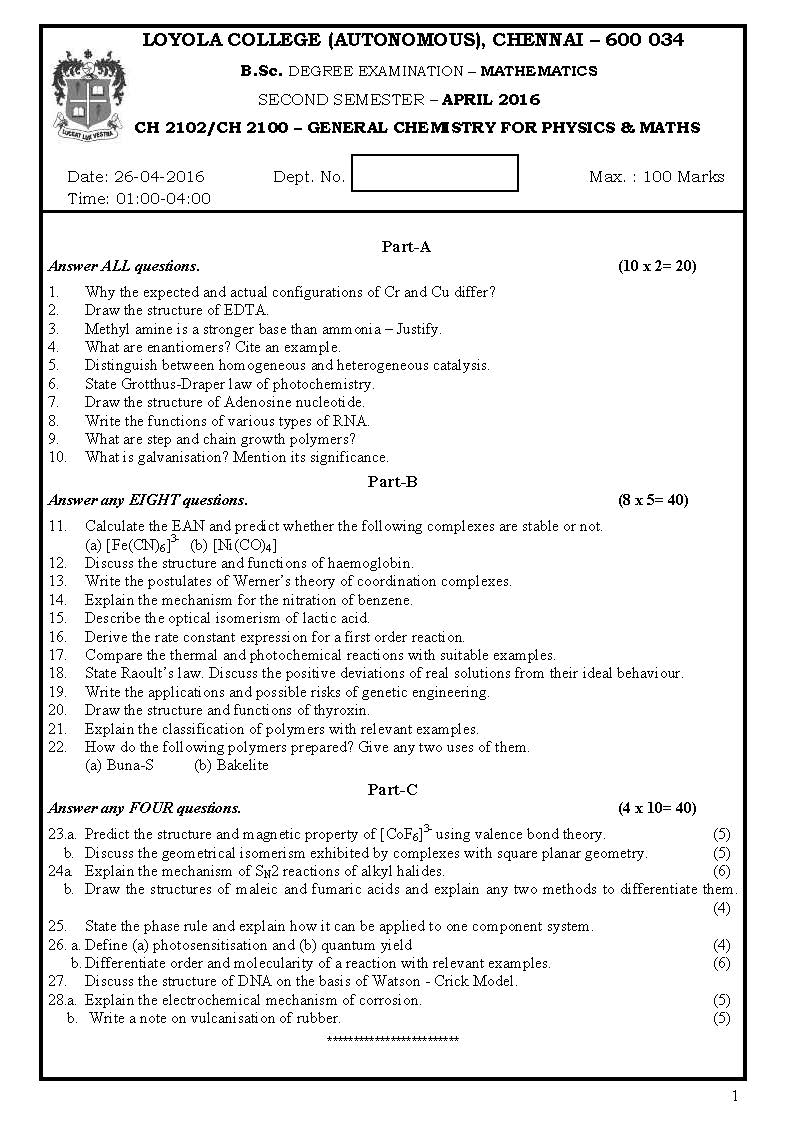LOYOLA COLLEGE (AUTONOMOUS), CHENNAI – 600 034
SUPPLEMENTARY SEMESTER EXAMINATION – JUN 2006
B.Sc. DEGREE EXAMINATION
CH 3200 – GENERAL CHEMISTRY FOR PHYSICS & MATHS
Date & Time : 28/06/2006/9.00 – 12.00 Dept. No. Max. : 100 Marks
PART-A
Answer all questions (10×2=20)
- What principle is used in the separation of o-nitrophenol and p-nitrophenol?
- Draw any two structures of aromatic polycyclic hydrocarbons.
- What are chromosphores? Give an example.
- Write any two uses of aspirin.
- State Hess’s law.
- What is a zwitter ion? Give an example.
- How is glycine synthesized from a-chloroacetic acid?
- State I law of thermodynamics.
- Give any two examples for radioisotopes.
- How is BHC prepared?
PART-B
Answer any eight questions. (8×5=40)
- Explain the origin of hydrogen bonding using the theory of dipole-dipole interaction.
- What is lanthanide contraction? Explain.
- Write the mechanism of nitration of naphthalene.
- Explain any three electrophilic substitution reactions of furan.
- Draw the structure of penicillin and give any three uses of the same.
- Define the following term:
- a) enthalpy of formation b) enthalpy of neutralization c) EMF
- Write a note on primary electrode.
- Derive Kirchoff’s equation.
- Draw and explain saturated calomel electrode.
- Discuss the structure of glucose.
- Write a note on a) calorific value of fuel b) octane number.
- How is urea synthesized?
PART-C
Answer any four questions. (4×10=40)
- Discuss in details Born-Haber cycle for calculating lattice energy.
- a) Explain the Haworth synthesis of naphthalene. (5)
- b) Explain any one method of preparation of pyrrole. (5)
- a) Write short notes on sulpha drugs. (4)
- b) Discuss the different types of conductometric titrations. (6)
- a) What is equivalent conductance? How is it determined? (5)
- b) Explain Sanger’s method for the determination of N-terminal group of proteins
- a) What are the factors influencing the activity of enzymes. (5)
- b) Explain the primary structure of proteins.
- Discuss the salient features of fractional distillation of petroleum. (10)
